Want to create a planted aquarium? Looking to add some extra green to your shrimp or betta tank? This article will give you an overview of various beginner-level plant species you’ll encounter in the hobby, sorted in arguably the most natural way: by genus.
A genus is a level of taxonomic classification one rank higher than species. Simply put, a genus can contain multiple species.
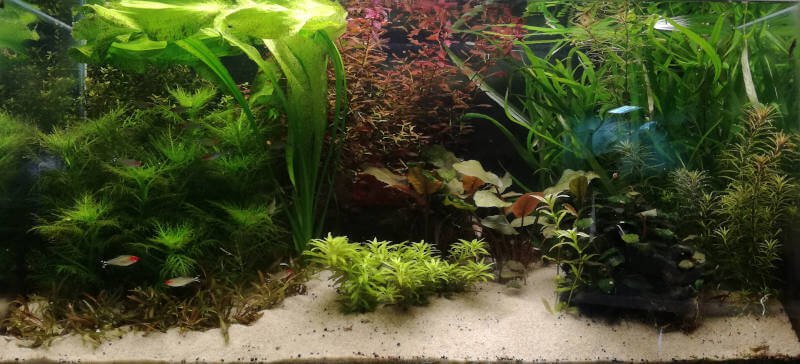
Own work, ‘Bad Dutch style layout’
The scientific identification for any species consists of two parts: the genus name and then species name. This is a form you’re probably familiar with, even if you don’t realize it.
A well-known example is Tyrannosaurus rex. ‘Tyrannosaurus’ is the genus name, and ‘rex’ is the species. The same rule holds true for plants – for example, Hygrophila difformis. This plant is from the genus, ‘Hygrophila’ and the species is ‘difformis.’
Besides the scientific name, there are also casual or common names – nicknames, so to speak. The common name for our Hygrophila difformis example is ‘Water Wisteria‘.
A big advantage of learning scientific names is you can gain a rough idea what to expect from all members of a particular genus. In this guide, we’ll go through several commonly encountered genera (the plural of genus), and break down a few of their traits and prominent members.
Common plants by Genus
1. Anubias
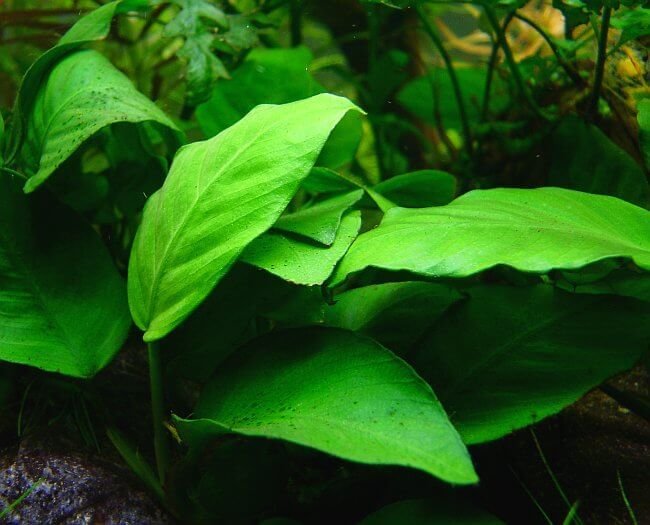
Anubias barteri var. Nana (source) by Ark
Anubias is a plant genus with leathery, shiny, spear-shaped leaves with smooth edges and a pronounced tip. Unlike common garden plants, they don’t have thin stems, but rather a thick, tuber-like rhizome. They are exceptionally slow-growing plants and are very tolerant to low-light conditions. Very few nutrients are needed for their growth, so supplemental fertilization is typically not necessary.
They do have the odd quirk that they need to grow with their rhizome exposed to the water, or else they’ll rot and die. When placed onto rocks or driftwood, they’ll root onto it over several months, though you can easily help them out with Cyanoacrylate Super Glue. They are probably the closest living thing you can find to plastic plants.
Prominent members:
- A. barteri – One of, if not the most common aquarium plant for beginners, this is the most typical Anubias.
- A. barteri var. nana. – As a smaller-leaved variety, hence the ‘var.’ in the name.
- A. afzelli – This one has neat triangular leaves that make surprisingly good food bowls in a shrimp tank.
2. Cryptocoryne
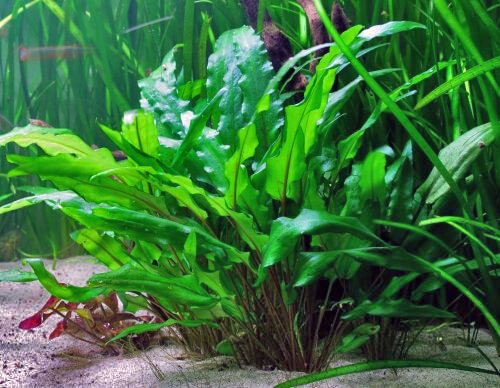
Cryptocoryne wendtii ‘Green’ (source) by Tommy Kronkvist
Cryptocoryne, also known as the water trumpet, is a genus of plants that grow stalked leaves with parallel veins on a short rhizome. They are not stem plants but rather rosette plants that grow only about as high as their leaves are long. All members of the genus Cryptocoryne are exceptionally well-rooting plants that can make roots up to a meter (three feet) long.
Cryptocoryne are slow-growing and tolerate low light very well. However, they are sensitive to rapid changes in the environment and will melt their leaves in response to stress. The rhizome will often remain unaffected and the plant will regrow a few weeks later. If you know your water is very different than that at the store and don’t want to deal with the discarded leaf fragments, you can trim them before planting.
Prominent members:
- Cryptocoryne wendtii – The Wendt’s Water Trumpet is the most common of the genus among hobbyists. It has relatively large leaves with ragged edges, and can grow up to 20 cm (8 inches) high.
- Cryptocoryne crispatula – This water trumpet has much smaller, longer, and more ragged edged leaves than C. wendtii. It grows up to 60 cm (24 inches) long and is a great background plant for larger tanks.
- Cryptocoryne parva – The Small Water Trumpet is the smallest member of the genus, growing only to about 5 cm (2 inches) in height. As it is very slow-growing, it makes an excellent plant-and-forget option for a carpet in CO2-deficient tanks.
3. Bucephlanandra
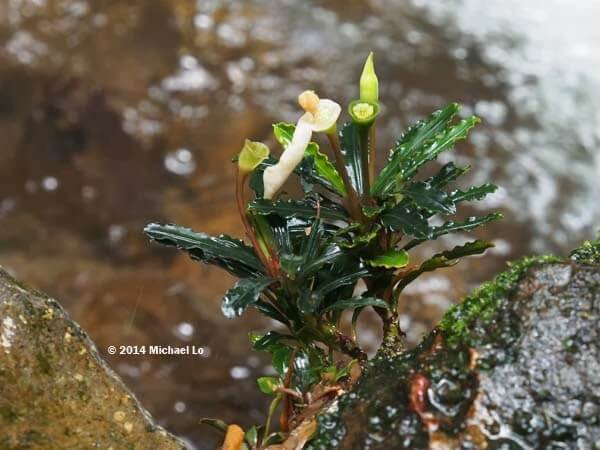
Bucephalandra Tebakang (source) by Dung Ca Xinh
Bucephlandra, commonly known as Buce, is a relatively undocumented genus of plant from Borneo. Like Anubias, they are all rhizomatous, meaning they grow from a rhizome. They all feature rippled leaves with blunt tips and slightly wavy edges. Among their beloved features are the gas-exchange openings on the leaves that show up as silver spots. The leaves are often dark, so they can look quite spectacular.
The scientific community has not fully described them so most often they use the naming convention, Bucephlandra sp. ‘[Place where it was found]’, or occasionally even unrelated fantasy names. They are very slow growing and also molt from stress, though aren’t as sensitive as Cryptocoryne.
Prominent members:
- Bucephalandra sp. ‘Wavy Green’ – This Bucephalandra is commercially available without being harvested from the wild. As the name implies it has light green, wavy leaves.
- Bucephalandra sp. ‘Red’ – The name of this species comes from the fact that its rhizomes can become a deep red color, contrasting nicely with its darker, green leaves which unlike other varieties are not particularly wavy.
4. Vesicularia
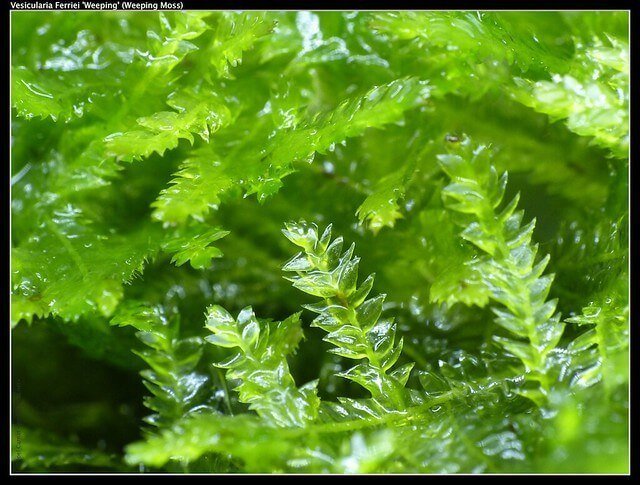
Vesicularia ferreii ‘Weeping’ (source) by Joel Carnat
Our first moss on the list! Vesicularia is a Genus of common mosses. Mosses, unlike the higher vascular plants, lack structures to move water and sugar through their bodies. This means they’re much more limited in size and typically much finer in texture. In aquarist terms, it also means you don’t have to deal with roots, but rather can place or glue the mosses where you choose, and they’ll do just fine. They offer excellent hiding space for fry or surface area where shrimp can graze.
With small size comes a high surface-area-to-volume ratio and thus a sensitivity to surface anti-algae treatments like Seachem Excel (Glutaraldehyde). Vesicularia mosses are all small, green strings that primarily differ in the way they branch. They are fast growing and tolerant of low light conditions.
Prominent members:
- Vesicularia dubyana ‘Java’ – The Java moss is a classic aquarium plant. It’s exceptionally vigorous and grows quite randomly, making neat little bushes.
- Vesicularia montagnei ‘X-mas’ – This is the Christmas moss, So named because its growth shoots resemble X-mas trees.
- Vesicularia ferriei ‘Weeping’ – Weeping moss is quite similar to Java moss, but it grows a bit more evenly and under medium light will creep downward like a weeping willow.
5. Vallisneria
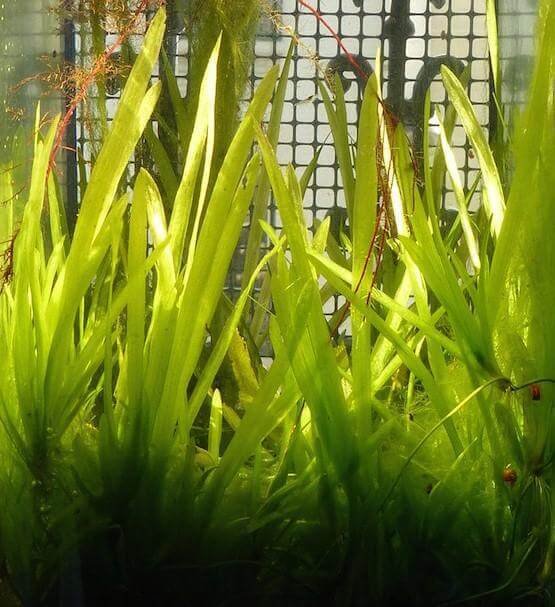
Vallisneria: 20 Liter no tech tank, cropped (source) by Jeal Carnat
Vallisneria, also known as eelgrass or tape grass is a genus of fully aquatic plant that grows long, translucent, tape-like leaves that float upward. Being fully aquatic means that unlike most other plants that can, depending on the situation, also grow out of the water, these can only survive under the surface.
The plants are remarkably permeable and thus easily damaged by anti-algae treatments like Seachem Excel or hydrogen peroxide. They reproduce rapidly through runners in the substrate. They are exceptionally tolerant to low-light and make nice vertical structures in tanks.
Prominent members:
- Vallisneria americana ‘gigantea’ – The giant eelgrass can be easily recognized by its about thumb-width leaves that can grow to be several meters (as much as 12 feet) long.
- Vallisneria spiralis – The twisted tape grass has leaves that are twisted in a corkscrew shape.
- Vallisneria nana – This smaller species has long, straight, pencil-width leaves.
6. Hygrophila
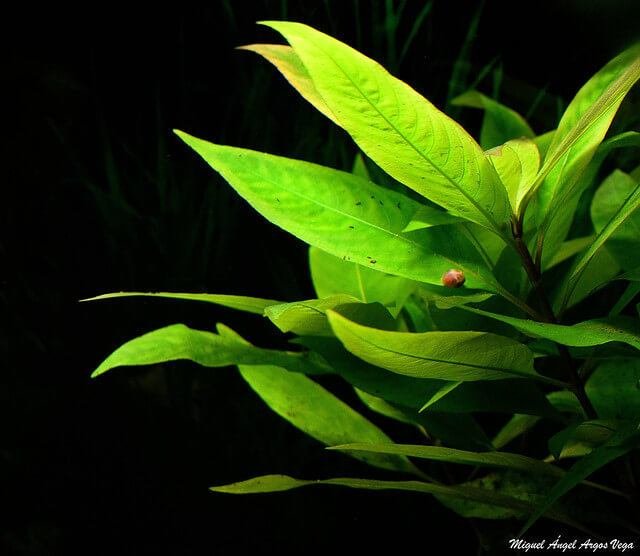
Hygrophila: Espada amazonica (sic) (source) by Miguel Angel Argos Vega
On to the stem plants! The first common genus worth mentioning is Hygrophila. It’s quite a diverse genus, but most Hygrophila in the hobby fall into two categories: those with spear-shaped leaves and those with feathered leaves. These plants are a bit more demanding and all need at least medium lighting to really thrive.
Hygrophila are hungry! With these it’s important to fertilize your tank, particularly with potassium. A lack of adequate nutrients will quickly show up in the form of yellow-edged pinholes in the leaves. Pro tip: you can make very pretty terraces by cutting the tops to the right length and replanting those tops where you desire.
Prominent members:
- Hygrophila difformis – Known also as the Water Wisteria, this is among the Hygrophila with feathered leaves. The leaves have a unique texture and are considered very attractive. They’re typically sold cheaply as bunch plants and even a small bush makes great cover for fish.
- Hygrophla corymbosa ‘stricta’ – H. corymbosa is one of the spear-shaped Hygrophila. It has very large, apple-tree-like leaves and stiff brown stems. Among its brethren it’s one of the more deeply rooting plants. If you go through the effort of giving it plenty of light and limited fertilization, it can reward you with orange or reddish leaves. There also exists a cultivar with a shorted distance between the leaf nodes, Hygrophila corymbosa ‘compact’ which is one of the largest-leaved foreground plants.
- Hygrophila pinnatifida – This is another feathered variety, though the “cutouts” don’t run as deep as those in H. difformis. It is the oddball of the genus in that it likes to bend over, creep, and grow onto objects. It is also one of the easiest non-green plants available, as it will readily keep its brown coloration, though a strong light source and N- or P-limited fertilization can bring out deeper colors.
7. Echinodorus
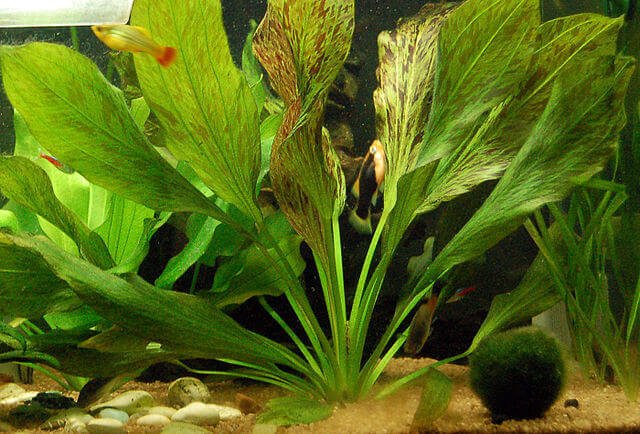
Echinodorus: Echino ozelot (source) by Marrabia2
Echinodorus is a genus of large-leaved rosette plants with many exceptional cultivars and hybrids created by hobbyists. Their leaves are roughly sword shaped and indeed are commonly called ‘swords,’ making them good centerpieces for larger tanks. As one of the strongest-rooting plants in the hobby they do best in a rich substrate but can also be grown in poor ones. Reproduction does not happen by the production of runners. Instead, a single plant will typically split in two or, more rarely, grow whole new plants from old flower stalks.
The genus was recently split up with Helanthium being categorized as its own genus. The primary difference is that Helanthium plants are smaller and generate runners.
Prominent members:
- Echinodorus grisebachii ‘Bleherae’ – Commonly called the Amazon Sword, this South American species is the most common sword plant and work well as eye catchers or as background plants in a larger tank. They are fairly robust and grow at a moderate rate. Though not really a low-light plant, they still do ok at the lower end of medium lighting.
- Echinodorus sp. ‘Reni’ – This is not technically a species, but rather a man-made hybrid. It features shorter, wider leaves with a noticeable red tint when the plant is young that shows up well under strong lighting. Due to their small size, lack of runners, and distinct texture, they make good foreground plants for a low-effort setup.
- Helanthium tenellum – Previously known as Echinodorus tenellus, this is one of the plants recategorized into Helanthium. It is the smallest type, reaching a height of only 10 cm (4 inches) at maximum. With its ability to make runners, ease of care, and relatively speedy growth, it makes a good choice for anyone who wants a nice carpet in a reasonable time.
8. Limnophila
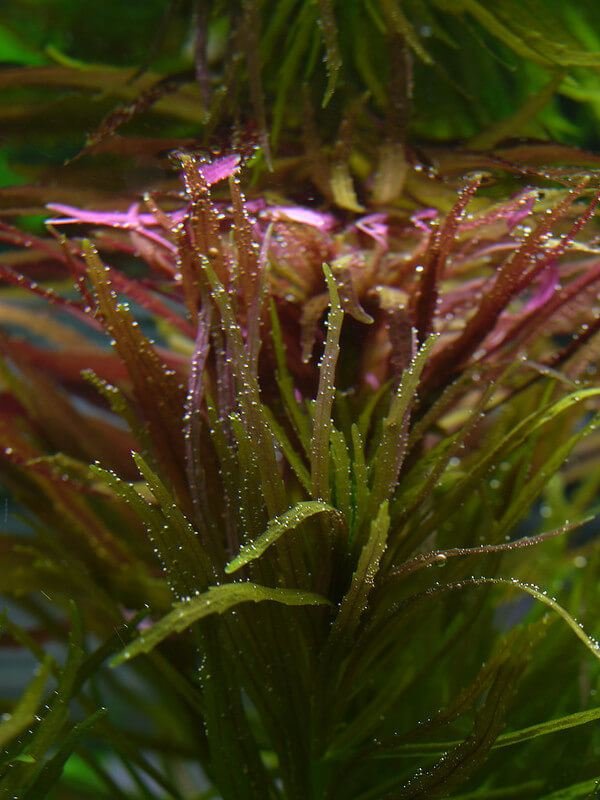
Limnophila: Rice Paddy Herb (source) by Emmilia Murray
The marshweeds or Limnophila are a genus of fast-growing stem plants. The most common species have whorled leaves (more than two leaves per node). A few others with opposed leaves do exist, but are less common. They have quite a turnover when it comes to nutrients and their fast output of new leaves means that a deficiency in micronutrients can sneak up quickly.
The common species fall into two categories: those with serrated, spear-shaped leaves and those with very fine, strongly branching leaves that are almost feather-like. They are all weakly rooting plants that can also be grown floating.
Prominent members:
- Limnophila sessiliflora – Known as Ambulia, this is one of the branched-leaved Limnophila. It does not need much light but does grow denser and bigger if given more light. Like mosses, its fine structures make it a well suited as a cover or grazing area.
- Limnophila aromatica – Also called Rau Om or Aromatic Marshweed, this is one of the spear-tip Limnophila varieties. As its name implies, it has a pleasant smell and can also be eaten as a herb. It has a lemon-like scent but tastes a bit spicier and makes a good tea. The L. aromatica species is quite variable; the leaves’ size, the number of leaves per whorl, and its color under stress can differ depending on its cultivar.
9. Rotala
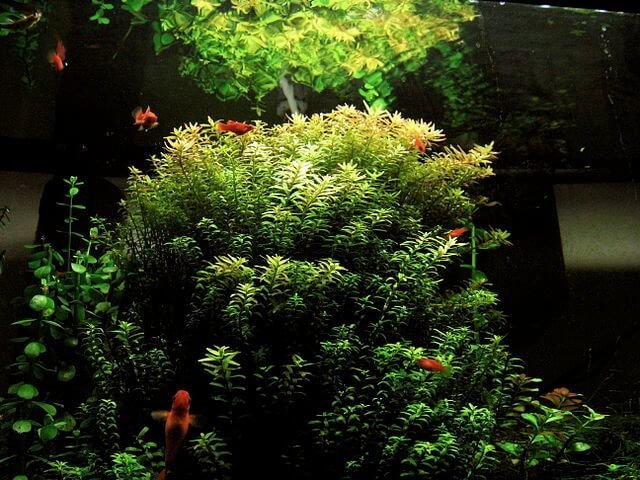
Rotala: Rotalaindica (sic) (source) by Stickpen
The Rotala genus consists mainly of smaller-stemmed plants that grow at a medium rate. They can be shaped into nice bushes by trimming them from the outside like hedges. The trimmed stalks will then sprout multiple times, making a denser bush. You can generally repeat this cycle several times before the lowest portion on the inside becomes too shaded and dies, forcing you to start the whole bush anew.
They are generally not the easiest plants for beginners, but you can keep them around until you’re an expert.
Prominent members:
- Rotala rotundifolia – The round-leaved Rotala is named for its round leaves in its out-of-water from, which looks very similar to the underwater form of the related Rotala indica. Indeed, you can frequently buy it mislabeled as such. R. rotundifolia is the plant for making well-shaped bushes without too much unique texture – often a perfect way to fill space. Under significant N- and P-limitation and strong lighting it produces more intense colors. Medium lighting should be maintained at a minimum, but strong lighting can help with the stressing.
- Rotala wallichii – This Rotala has whorled, needle-like leaves and behaves very similar to R. rotundifolia, despite having a very different shape.
- Rotala macrandra – Another common Rotala, this one is considered a more advanced plant than the others. Attempting to grow them without additional CO2 will likely fail. They are also sensitive in regard to pH and KH – an acidic pH and a KH of no more than a few °dH are needed for good growth. On the upside, they don’t care much about limited fertilization and will display stunning colors even without it. They are light hungry and prone to self-shading.
10. Ludwigia
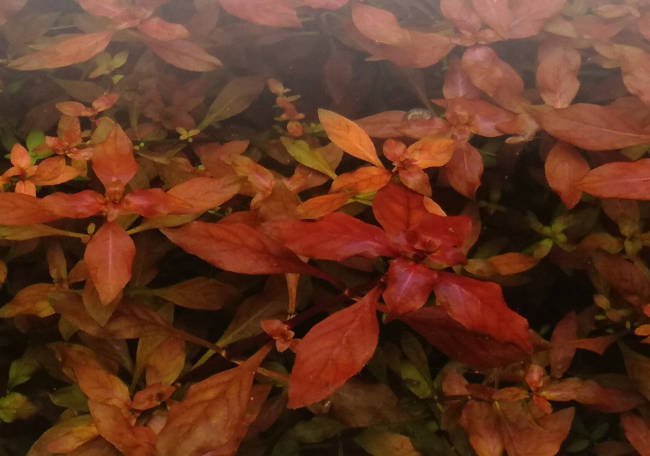
Ludwigia: Own Work, ‘L. palustris ‘Super Red”
The final genus we’ll look at is a common stem plant, but should be considered a moderate challenge in a tank without additional CO2: Ludwigia. This genus contains plants that are popular because they can produce stunning reds and oranges with moderate effort. They all grow at a moderate to high rate and are notably hungry for micronutrients, but are certainly worth the time and effort. They are best maintained by replanting tops.
The North-American Ludwigia are notorious for their ability to interbreed with each other in almost any combination.
Prominent members:
- Ludwigia palustris ‘Super Red’ – The red Ludwigia is a cultivar of the (normally) green L. palustris that gets exceptionally red or even dark purple under ideal care. Despite its stunning color its growth is quite unruly and demands a good amount of trimming and shaping to keep it neat. It’s one of only two opposed-leaved (meaning it has two leaves per node) North-American Ludwigia species.
- Ludwigia repens – This is the other opposed-leaved North American species. It features short leaf stalks and wider leaves than L. palustris. It does not get as red but doesn’t grow as unruly either. Quite a few neat cultivars take some influence from it such as L. sp. ‘Dark Orange’, with variegated leaves and a more orange color and L. repens x glandulosa ‘Rubin’, which is a hybrid between it and the very red L. glandulosa.
- Ludwigia glandulosa – The Star Ludwigia is a unique plant that has relatively long, thin, deep red leaves. It has alternating leaves – meaning one leaf per node – and the leaves curl nicely around the stem, making the view from above look like a red star. Unfortunately, this species needs extra CO2 to grow well.
Plant Care Basics
So now that you have your aquatic plants, how do you care for them? Plants have the benefit of being able to make everything they need from simple substances. Care primarily consists of light, carbon dioxide, and the nutrients you add as fertilizer.
For most practical purposes, it is enough to know that plants’ growth rate is dictated by their most limited resource. This principle is known as Liebig’s law of the minimum. The growth of plants is most often dictated by the most limited resource, so they do not generally grow as fast as their metabolism would otherwise allow.
Light, Water and Carbon Dioxide
Plants undergo photosynthesis. In oversimplified terms, this is the process of using light to turn water and carbon dioxide into sugar. The sugar is then used to build the plant.
Water, of course, is abundant underwater, so by cultivating in an aquarium, we’ve already checked off one of the key ingredients! Carbon dioxide, or CO2, is another component that is abundant; there is plenty of air all around us containing 400 ppm CO2. That Carbon dioxide dissolves into the water and enables plants to grow under water. Only a limited amount dissolves, but it is generally enough to scrape by.
Carbon dioxide is the main resource in nature that limits aquatic plant metabolism and, assuming you’re not limited by something else, nothing will give your plants’ growth a boost quite like adding extra carbon dioxide to your tank. But fast doesn’t automatically mean good and beginners in particular should aim for slow and steady. It is very possible to create stunning tanks without additional carbon dioxide.
For the beginner, a simple understanding of lighting consists of two parameters: amount and color. For better or worse, there are quite a few ways to measure lighting for plants, but two stand out as the most common.
First is the number of usable light particles that hit an area over time. If you specify the location and depth to the tank substrate, you can compare two lights. This measurement is called photon flux density or Photosynthetically Active Radiation (PAR). Measured at the substrate of a tank, low light would be below 10 µmol/m2/s and medium lighting would be in the range of 10-50 µmol/m2/s. High light, naturally, is beyond that level. There are not, however, official definitions of these ranges so the exact numbers used can vary from author to author.
Alternatively, you can measure the amount of light a tank gets by the amount your fixture emits. If you have a fixture of the same type such as a modern RGB LED bulb, you can just divide the amount of electric power it uses by the tank size. This method makes the assumption that the light gets equally distributed throughout the tank’s volume, and will result in a simple watt/gallon or watt/liter measurement. Sadly, LEDs, T5, T8, and HQI are all common lighting technologies for the hobby, but cannot necessarily be directly compared with one another using their published power use. A better measure is to just use the actual emitted brightness divided by your volume – the luminous flux per unit volume in lumen/liter. Every light sold in the EU, at least, has the lumens listed on it, making the measure a bit easier to access.
If you’re unfamiliar with the lumen (abbreviated as lm) rating, you can estimate it by looking up the type of light and its power efficiency. An LED emits about 100 lm/W, so a 5-watt LED emits about 500 lumen. Low light is below 10 lm/L (40 lm/gal), medium light is between 10-60 lm/L (40-240 lm/gal), and high light is greater than that.
All light has a wavelength, or color. However, the lights we use emit multiple wavelengths at once and we roughly estimate the color of a mixed-light source by comparing it to the glow of a hot object. For example, a red-hot piece of iron is about 1000°C (1800°F or 1300 K) in temperature, generating a primarily red glow. A 6200°C (11100°F or 6500 K) object will glow quite white, while a 10000 K object will give off a blueish glow.
Plant Nutrition
So beyond water, light, and carbon dioxide, what do plants need? We’ve already met the so-called primary macronutrients: hydrogen, oxygen, and carbon as sourced from water and carbon dioxide.
The secondary macronutrients are what we think of as fertilizer: nitrogen (N), phosphorus (P) and potassium (K). Nitrogen is part of the nitrogen cycle, which every aquarist should be familiar with. In stocked tanks without extra carbon dioxide your plants will usually not be able to take up all nitrogenous waste from your fish, so you’ll still need to change the water to remove the excess. On the other hand, very lowly-stocked tanks, very well-planted tanks, or relatively well-planted tanks with additional carbon dioxide may need extra nitrogen.
In a home aquarium most phosphorus other than fertilizer comes from the same detritus/fish food that also drives the nitrogen cycle.
Potassium (K) is another major player among the macronutrients, the main source for which is simply the influx of new water. Potassium can more easily become a limiting factor than can N or P, so fertilizing K is often a good idea, especially if you have plants that need a lot of it.
Technically there are also the tertiary macronutrients, calcium and magnesium, but they are both part of water’s “General Hardness” (GH) and will be abundant in all but the softest waters.As a rough guide, the ratio of NO3 (your source of N), PO4 (for P) and Fe by weight in most tanks is roughly 100:10:1. If you deviate significantly from these factors of ten, your plants are unlikely to do well.
Now you know the nutrient players, so what’s the right way to fertilize? First off, you must decide what you want to achieve. Do you want fast, green growth? Are you aiming for slower growth and less trimming? Or do you want the most color out of your red plants?
For the fastest growth, it is the best to avoid limiting your nutrients: Fertilize (or even over-fertilize) everything and don’t forget to change out the water frequently
Do you prefer to trim a little less and have slower growth? Want to do fewer water changes? If so, you can limit a certain nutrient as a way to moderate the rate of growth. Common phosphate-limiting systems are the Perpetual Preservation System (PPS) and Perpetual Preservation System Pro (PPS-Pro).
What can you do to improve the colors of your plants? The answer may sound surprising: stress your plants. This works because every nice red and brown color is a stress response, typically towards excess lighting, but sometimes also due to nutritional stress. Approaches that limit N and/or P in particular tend to result in better colors.
A word on algae: the healthier, faster growing, and less stressed a plant is, the better it can out-compete algae by producing algae-suppressing substances. The right fertilization regime is very much a balancing act between what your particular ensemble of plant species need, how much you want to stress them, what you feed them, and what other sources (like food/water changes) give them. And much like clothing, for the best results you can try different ones out, adjust as needed, or even make your own from scratch.
The Water and the Substrate
Now let’s talk about how we get the nutrients to the plants: it may be surprising, but ‘through the roots’ is not the only answer. Plants also absorb nutrients through the leaves, stem, and really all other portions of their surface. Water offers a big advantage in that you can easily measure how much of a nutrient is in solution. After that, you can easily adjust based on how much you measured. But dosing the water means you’ll also need to replenish the nutrients more often. As a rule of thumb, the mass of the fertilizer needed in four liters (one gallon) of water is about equal to the mass of a rice grain.
Major water parameters such as temperature, pH, GH, and KH are less important for beginner-level plants. Most plants in the hobby are tropical or subtropical in origin, so they’ll tolerate moderate water temperatures between about 18°C (64°F) and 28°C (82°F). A pH that’s not too far out of the norm – about 6.0 to 8.5 – will also be fine for common species. As long you have some GH for nutrition, the plants listed above will do fine. Almost any tap water will have some GH, but water softeners may exchange a significant portion of the GH for something else (usually sodium) which is not a necessary nutrient for plants.
Filtration is a more minor factor in plant care, but of course the nutrients in the water must have the opportunity to reach the plants themselves. If you add CO2 to the water, the gas has to reach the plant fairly quickly. At minimum, the filter should cycle the full volume of the tank twice per hour. If you depend on your plants for ammonia removal, you may want to run the pumps at a higher rate than just this bare minimum. There are, however, no notable benefits of going beyond a pump rate of ten times the tank volume per hour. Too much pumping can damage the plants physically, more than cancelling out any minor nutritional benefits.
Substrates offer certain advantages and disadvantages. They allow your plants to root where they choose and search out nutrients themselves, but they don’t offer you much influence over how much nutrients they actually take up. However, many aquatic plants only root weakly in the substrate and some not at all, so the option is not always available.
In general, there are three broad categories of substrates:
1. Inert substrates
These do nothing. ‘Inert’ literally means they do not react, so the name is the program: substrates like sand or gravel will do nothing more like offer something for the plants to hold on to. But of course, that means you don’t have to account for built-in nutrient levels or other factors. If you want to replant frequently – for example, if you are maintaining bushes of stem plants – these make a good options.
2. High-CEC substrates
‘CEC’ stands for Cation-Exchange-Capacity, or the ability to transfer cations. Clay-based substrates like Akadama or Seachem Flourite fall into this category. They’re a good option to smooth out an irregular fertilization schedule without the mess of the next category.
3. Substrates with organic matter
These substrates bring nutrients of their own to your tank in form of organic matter. They also reduce the pH of the water.
Combined approaches are also possible. As usual, it can take some experimentation to find the right balance.
Closing remarks
If you have more questions or comments, please visit the comment section!
Further Reading:
-amzn-asin=”0967377366″>’Ecology Of The Planted Aquarium’ by Diana Walstad is a great book for the beginner. It outlines every process that happens in a planted tank. Albeit a bit older and technical, it is still a great resource.
Plant Nutrition on Wikepedia, while more for plants in general, it dives a bit deeper into the individual nutrients.
NavigationCommon plants by Genus1. Anubias2. Cryptocoryne3. Bucephlanandra4. Vesicularia5. Vallisneria6. Hygrophila7. Echinodorus8. Limnophila9. Rotala10. LudwigiaPlant Care BasicsLight, Water and Carbon DioxidePlant NutritionThe Water and the Substrate1. Inert substrates2. High-CEC substrates3. Substrates with organic matterClosing remarks

